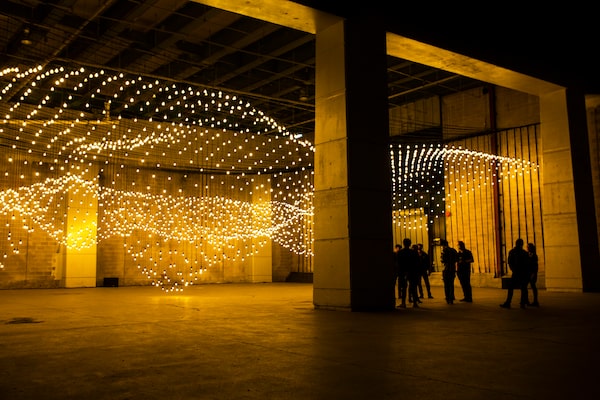
Pulse Topology, an installation by media artist Rafael Lozano-Hemmer was presented by The Bentway and Exhibition Place in a space underneath the Gardiner Expressway.Shane Parent
We were under the Gardiner Expressway, and the zoom of cars overhead blended with a low, irregular hum: the sound of a thousand heartbeats, thumping together. A lattice of light bulbs pulsed in time to their rhythm.
This was Pulse Topology, a multimedia installation by Mexican-Canadian artist Rafael Lozano-Hemmer. To get here, my family and I had walked along an old rail corridor west of downtown Toronto and into this enclosed space on the back end of the Canadian National Exhibition grounds.
The starting point of this journey was the Bentway, the public space underneath the Gardiner. It’s not technically a park, but a public venue for culture, skating and hanging out. Now the organization that runs it is growing its ambition. The Bentway is working with the city on a new “public-realm plan” that could extend its approach – and events like last month’s Pulse Topology exhibit – to spaces all along the downtown expressway.
“The original idea for the Bentway was always to go beyond the one-kilometre stretch that we’ve built,” said Ilana Altman, co-director of the organization. This began with Pulse Topology as the first step. The Bentway – which now presents a range of art installations, events and performances – collaborated with Exhibition Place, a city agency, to open up that room under the highway. Known as a “cubicle,” the vast space usually holds bleachers and garbage cans. But Mr. Lozano-Hemmer’s moving installation revealed that this tall box of concrete slabs and blocks, high-ceilinged and rich with patina, could be a place for art and gathering. “The creative power of a wild idea can seed all this new thinking about the possibilities of a space,” says Dave Carey, the Bentway’s other co-director.
Former Toronto chief planner Jennifer Keesmaat offers lesson on high-design affordable housing
This is the magic of the Bentway, both as a place and an upstart cultural organization. Its mandate is to create art and “social engagement” in public space; its open-air zone has become the unofficial public square for a new condo neighbourhood in the area and a novel destination for other Torontonians.

The Bentway is working with the city on a new 'public-realm plan' that could extend its approach – and events like last month’s Pulse Topology exhibit – to spaces all along the downtown expressway.Shane Parent
Back in 2019, the Bentway collaborated with a local business improvement association to remake the intersection under the Gardiner at Rees Street. Now this effort is expanding. Last month, the organization announced the short list for the Waterfront ReConnect Design Competition, which solicited designs for two more intersections. The shortlisted design teams include some innovative talents, such as Winnipeg architects 5468796 and Toronto’s SOCA.
The nascent public-space plan will extend this approach east to Jarvis Street. In between, tens of thousands of people will move into new high-rises; at the eastern edge, the agency Waterfront Toronto is building new neighbourhoods and creating a new body of parks and public art.
For the city, the goal is “to turn a barrier into a gathering place and a pedestrian corridor,” said Heather Inglis-Baron, a city planner who is working on the project. “With the success of the Bentway, we’re able to see what could happen with these spaces where formerly no one wanted to be.”
This inventiveness is exciting – and all too rare. Any big city has its leftover bits. Toronto has chosen to cram thousands of new residents into its leftover industrial lands. Those residents are sometimes starved for amenities and a sense of place, even as billions of dollars of private and public investment reshape these areas.
And at the moment, the Ford government is privatizing Ontario Place and the city is trying to build a big suburban shed for e-sports at Exhibition Place. The future of the public realm in downtown Toronto needs help.
The solution is a sensibility that pays attention to what’s on the street, breaks through departmental barriers, and brings in excellent creative talent – like Mr. Lozano-Hemmer or the landscape architects PUBLIC WORK, who designed the Bentway and are consulting on the public-realm plan.
Ms. Altman says the lesson of Pulse Topology is clear: “We are all seeing that we can’t just use our public spaces for one purpose. They have to do many things.” That’s how a city works – when it works well.
Editor’s note: An earlier version of this article referred to the winners of a competition when in fact it was the short list.
Get inspired by the weekly Sightseer newsletter, with travel advice, destinations and more. Sign up today.